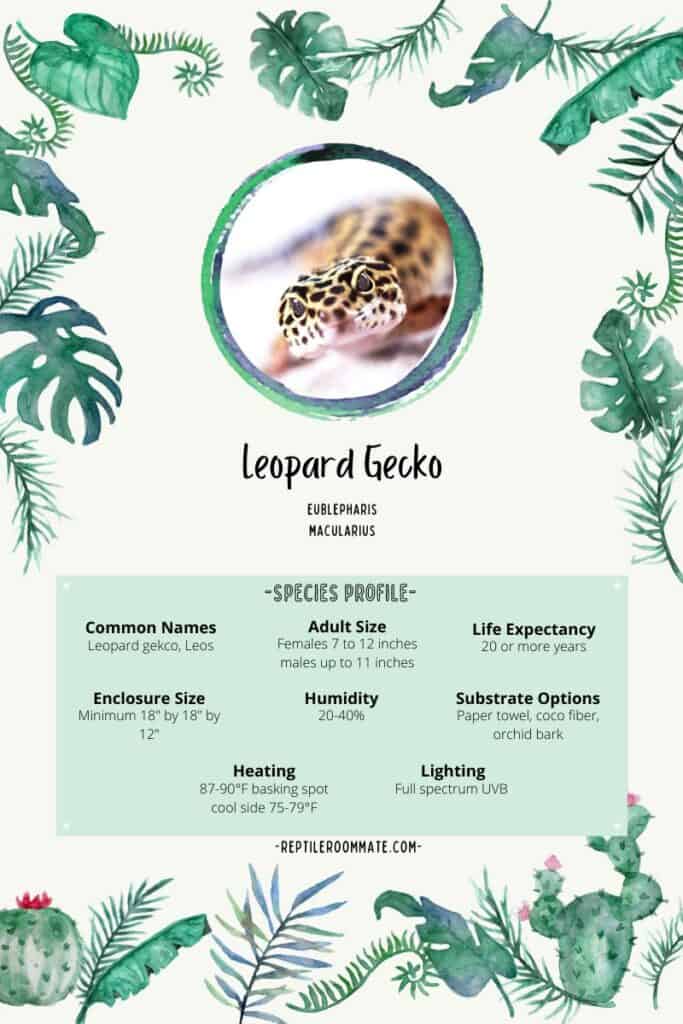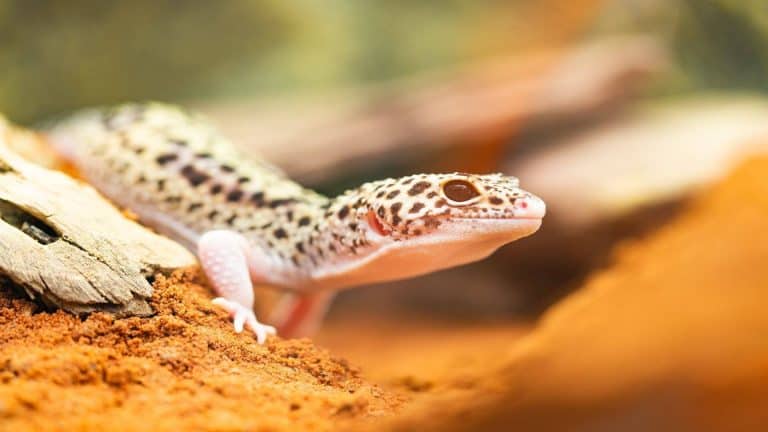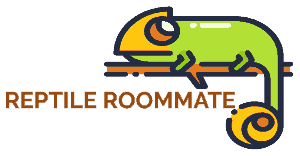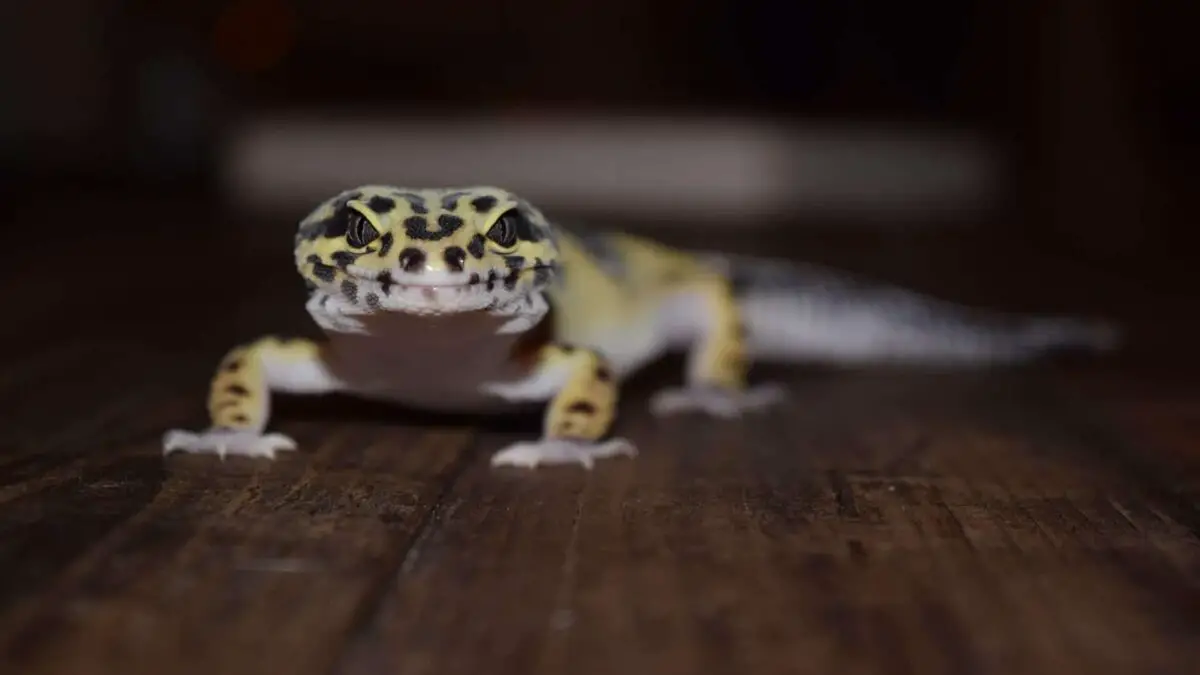Comprehensive Leopard Gecko Care Guide
Caring for a leopard gecko can be one of the most enjoyable aspects of pet ownership! These geckos will absolutely steal your heart!
This care guide will provide you with all the information that you need to successfully setup, maintain, and care for a pet leopard gecko. But first let’s start with some basic leopard gecko info.
Reptile Roommate is a participant in the Amazon Services LLC Associates Program. As an Amazon Associate I earn from qualifying purchases.

Leopard Geckos In the Wild
Leopard geckos are found throughout Southern Asia and the Middle East, from Pakistan and Afghanistan to parts of India.
They are found in rocky, dry, grassland, and in desert environments. Leopard geckos are most active near dawn and dusk although captive animals can be quite active during many parts of the day.
Size and Coloration
Leopard geckos range in size from about 7-9 inches for females and upwards of 11 or so inches for males. Newly born hatchlings are 3- 4 inches in length.
In about 10-12 months a leopard gecko is considered to be full grown.
The life span for leopard geckos are, on average, approximately 10 years, although well-taken care of individuals’ can live 20 years or more!
Leopard geckos in the wild tend to have dark, drab, and dull coloration. Their captive counterparts however typically have bright colors, patterns of all kinds!
These color and pattern variations are what’s known as “morphs.”
There are nearly endless morphs; beautiful color and pattern combinations that can be found among captive bred individuals.
Are Leopard Geckos Difficult Pets?
Leopard geckos are a “perfect” first pet or beginner reptile pet!
Their setup and care is simple and they can be very forgiving of even novice mistakes.
Leopard geckos are solitary animals that spend most of the day in burrows or underground coming out at night (when it’s cooler) to eat.
They are generally very easy to tame and handle with the vast majority of individuals being very docile.
You might be surprised to hear them squeak or chirp as they are known to be quite vocal!
Leopard geckos will also whip and shake their tail, when excited about the prospect of food or especially when focused on mating and mating display.
Both the chirping and rapid tail movement will definitely take you off guard the first time or two that you witness it but these are quite normal aspects of gecko behavior.
One thing a leopard gecko can’t do is climb walls or slick surfaces like their popular reptile counterpart, the crested gecko. They lack the adhesive lamellae (toe pads) that other geckos have so you won’t find them climbing up your bedroom wall or escaping up the sides of glass terrariums and habitats.
Do Leopard Geckos Bite?
The fact is that anything with a mouth can (and probably will) bite you; at least at some point over your reptile keeping career.
That said, a bite from even an adult leopard gecko really is nothing to be worried about. It feels like a small pinch and the most dramatic thing about it is that it might scare or surprise you rather than hurt you.
In the rare case that a leopard gecko bite draws blood (very rare) just make sure to clean the area well by washing and covering the area with a small bandage.
Leopard Gecko Handling
Leopard geckos take well to handling and are seldom bothered by being picked up. However, like many geckos they do need to be handled with care.
Never pick up or hold your leopard gecko by the tail.
Leopard geckos can drop their tails when threatened or frightened. This is called caudal autotomy. While they do regrow their tails this causes a tremendous amount of stress and loss of fat stores for the gecko which can lead to ill health or sickness.
Also, regrown tails will almost always be shorter and thicker than the gecko’s original tail size and length. (they are often smoother and will also lose some of the rigidity and intense coloration of the normal tail)
Creating Your Gecko’s Enclosure
Leopard geckos do great in tanks and terrariums between 20-40 gallons on size. A minimum of 18″ by18″ by 12″ is required. Breeders and some geckos keepers even house their animals in Rubbermaid or Sterlite tubs.
There is One Golden Rule for housing leopard geckos; DO NOT house males together. They will fight, they will hurt each other and BOTH will suffer, possibly even die.
Females of similar size can live together, approximately 2-3 females in a 30-40 gallon enclosure.
Just keep in mind that the more geckos you have the larger the enclosure and the more hides that you’ll need.
Housing a male and female together is okay as long as they’re similar size, just be prepared for a constant supply of babies.
You want to be sure that your enclosure has a secure screen lid or top (mostly to keep other things out rather than your leopard gecko in) that provides adequate ventilation and support for a light if needed.
Leopard Gecko Hides and Humidity
Your leopard geckos will require a “hide” on the warm side of the habitat. (more about temperature later)
Commercially available half-logs, reptile caves, or even a cardboard box can make a great hide for your gecko .
A second hide, a moist hide, is essential to prevent shedding issues as your geckos grows and periodically sheds its skin. (more on shedding later..)
This “damp hide” will need to have a substrate that can hold onto moisture without being wet.
Some great substrates that accomplish this are paper towels, coco fiber, vermiculite and the two most widely used; sphagnum moss and peat moss.
You want to make sure to dampen your substrate but not soak it and over saturate it increasing your chances for mold. You will, along with all substrate, want to change out the moist-hide substrate when it gets dirty.
There is a balance that you want to keep between too much humidity and too little.
Too little and your gecko can have problems shedding, too much and they can develop infections.
It’s best to keep humidity levels around 20-40%. The best way can test your humidity by using a simple and inexpensive hydrometer.
Substrate
Good Substrates
Simple substrates such as paper towels, newspaper, and shelf liners work great. Commercial options like Repti-carpet are also good.
Leopard geckos tend to use one area of the enclosure to go to the bathroom, so it can be easier to spot clean this “area” multiple times without having to remove and clean the entire substrate each time.

Poor/Bad Substrates
Most experts avoid using sand as a substrate. There is a possibility that your gecko can ingest the sand and suffer from intestinal blockage or impaction.
Wood shavings pose a problem because of the oils found in the wood that are very irritating to your geckos feet.
Avoid any/all commercial plant soils or substrates that may contain fertilizer or pesticides.
Heating
The simplest and most effective way to heat your leopard gecko’s enclosure is with an under-tank heating pad or heat tape.
Do not use heating rocks or stones that go inside of your enclosure. These can cause severe burns for your gecko.
Temperature
Temperature, or better put, temperature gradient (zones) are very important to health and well being of you leopard gecko.
What does this mean? Well, you want to create zones of temperature within the gecko’s enclosure.
A “hot side” between 87-90°F (which is the same side that has your “warm hide”) and a “cooler side” between 75-79°F.
To create the hot side you’ll position your under-tank heating pad towards the end of the enclosure.
That way the enclosure will be warmer nearest the heating pad and cooler the further away from the heating pad. You’ll adjust the thermostat until you reach the desired temperature between 87-90°F.
On this “cooler side” is where you want to place your moist-hide that we mentioned earlier.
An accurate thermometer is a must for any leopard gecko enclosure.
Lighting
Leopard geckos are nocturnal and therefore don’t need to bask under special UVB bulbs or lamps.
Lighting is much more for your enjoyment than your geckos.
A simple low-watt light can be placed overhead or on the screened cage top for 8-12 hours a day.
Leopard Gecko Care Guide Checklist
- Suitable enclosure (tank, terrarium, etc)
- Hide boxes, caves, half logs (moist hide & warm hide)
- Substrate (easy to clean and safe)
- Heating (warm and cool zones)
- Thermometer and hydrometer (calculate temperature and humidity)
- Lighting (UVB not necessary)
Food and Water
Water must be available at all times. A shallow, stable water dish should be provided. It should not be too deep that your gecko cannot easily crawl out of it.
Leopard geckos are insectivores; they eat crickets and mealworms. An occasional hornworm, dubia roach, or wax worm can be good supplements.
Always feed insects nutritious food for at least 24 hours before they are fed to your gecko. Insects that are “gut-loaded” in this way provide your gecko with the best nutrition.
Things like fresh vegetables, fruits, tropical fish flakes, and commercial reptile food are some examples.
Before feeding your gecko, feeder insects should be “dusted” with specially formulated calcium, vitamin and mineral powders. This is as simple as sprinkling a bit of powder on the insects to be fed and then feeding them to your gecko. (LINK)
Just make sure that you don’t have an excess of powder getting all over your gecko’s enclosure or the gecko’s eyes and body.
Baby and juvenile should be fed 5-7 small crickets or mealworms every day until they are about 4” or so.
Large food can be offered every day or so until they are full grown.
Adults can take 6-7 large crickets or mealworms 2 or 3 times a week. Supplementing with waxworms, hornworms, etc you should offer 3-5 worms 3 times a week.
Shedding
As leopard geckos grow they need to shed their old skin to make room for the new growth.
Fortunately shedding is something that leopard geckos usually handle with ease. (they will many times even eat their shed skin)
The main thing you must do as a pet owner is provide them that sweet-spot of 20-40% humidity and they will take care of the rest.
However, if you gecko does show signs of a stuck shed, many times on the toes) have them soak in slightly warm water for a while and help them by rubbing the stuck shed gently with a q-tip.
Notice that I bolded the word “rubbing.” The last thing you want to do is force or pull at stuck skin. Give it some time in the warm water and be patient.
Common Health Problems
One of the most serious and common afflictions that a leopard gecko can suffer is metabolic bone disease (MBD). Leopard geckos need calcium in their diet (the reason for dusting their food) and if they don’t get enough calcium and vitamin D it can cause a host of spine and limb deformities.
Impaction is another serious and all too common health problem for leopard geckos. Eating and ingesting substrate is the main cause of impaction. Feeding your gecko a meal that is far too large to be eaten easily can also lead to impaction.
Prolapses, parasites, (especially from wild caught individuals) and burns (from the use of heat rocks or lamps) are also serious problems facing these geckos.
If you have any question or concern about your leopard geckos health please contact your local veterinarian!
Leopard Gecko Care Conclusion
We hope this care guide will answer some of your questions, provide you with a resource for information, and help you maintain a happy and healthy leopard gecko!

